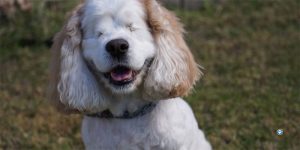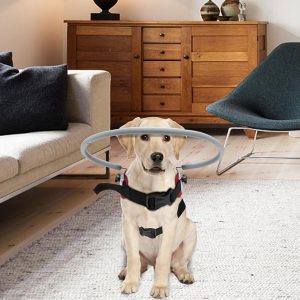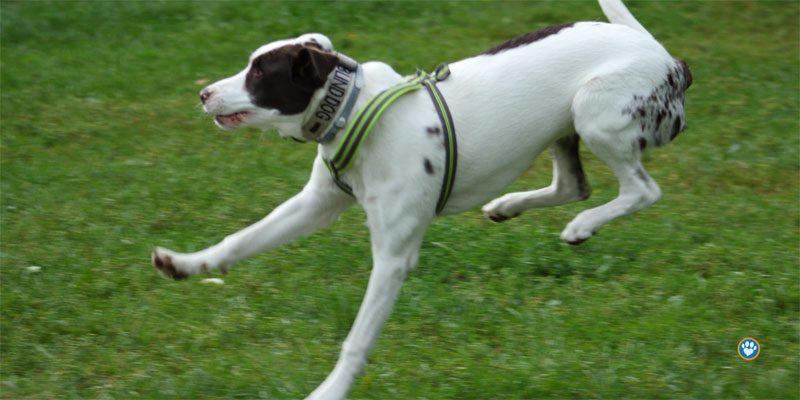Caring For Your Blind Dog.
Dogs who are blind, or have impaired vision, can live equally fulfilling lives as dogs that can see – they just need a little more support and understanding from caring owners. For tips and advice on caring for your blind dog read our Holidays4Dogs article.
It can be quite upsetting for dog owners when they realise that their companion is losing their sight, or goes blind altogether. However, dogs are pretty resilient creatures and usually adapt well to sight loss. Most can continue to live enriching lives with the help of an understanding owner.
Why do dogs lose their sight?
Sight loss can be due to a number of factors.
Age – sight loss is common in elderly dogs.
Disease – there are several diseases such as diabetes or kidney problems that can contribute to the onset of blindness. In addition some breeds are prone to hereditary disease such as PRA ( progressive retinal atrophy), glaucoma, and PLL (primary lens luxation), amongst others.
Injury – sight loss is possible when the eye becomes damaged.
Head shape – some breeds like pugs and cavalier king Charles spaniels are at greater risk of blindness due to the shape of their skulls.
What signs suggest my dog may be losing their sight?
If you think your dog may be losing their sight, it is important to arrange a consultation with your vet as soon as possible. Here are some signs to look out for that may indicate the onset of sight loss.
Cloudy eyes.
Bumping into furniture and barriers.
Disorientation.
Sudden fearfulness such as refusal to go outside, or for walk.
How to set up your home to help your blind dog feel safe.
Even dogs that can see like routine and familiarity, but for a blind dog this is crucially important. Making sure your dog is dog-proof will help to keep your dog out of danger and give them confidence to navigate their home safely.
Remove any objects or furniture that could injure your dog such as low coffee tables. Try to do the same in the garden.
Use stair gates to ensure your dog can’t access hazardous areas, or fall down flights of steps.
Consider covering slippery floors.
Avoid picking small dogs up as this can be quite disorientating for them.
Try not to move furniture around as your dog may find this unsettling if they run into it. The same goes for garden furniture, plant pots etc. It can discourage the dog from moving around in the future.
Keep water and food bowls in the same place. A good tip is to buy a fountain-type water bowl, so the sound of the water helps the dog locate the bowl. A good choice is this one from BEMOONY. It’s marketed for cats, but is equally suitable for dogs.
Help your dog to develop a mind map.
Just like the water bowl idea, you can provide clues around the home to give your dog a sense of spatial awareness. You could place mats in front of doorways, or near their bed, for example. Perhaps place coir mats at the foot of steps in the garden, so your dog knows when to step up. A wind chime near to the access doors will help guide your dog back from the garden.
Is there any special equipment that could help my dog?
If your dog is having difficulty navigating their space, you could try a halo tube. This is a lightweight tube that sits around your dog’s head and is attached to a harness.
It prevents the dog from crashing into obstacles and can give dogs a bit more confidence.
This blinder dog halo from CYPREASON is lightweight and comfortable to wear, without affecting the dog’s movement. Like all new things, its a good idea to get your dog used to wearing it gradually.
You may also want to consider alerting other people that your dog is blind. This dog lead from DEXIL has ‘Blind Dog’ stitched into it and may prevent accidents by warning other people your dog has a disability.
Similarly, you can buy lightweight vests, like this one from FLEXI-PRINT that provide a warning to others that your dog is blind.
Sound focus.
Caring for your blind dog involves using sound will help your dog to focus and understand what is likely to happen next. For example, say your dogs name before you touch them, as this will ensure they are not startled. Ensure that everyone in the household, especially children, are aware of this. Over time, you can teach your dog various cues so they can start to predict what will happen. Say “paw” for example when you need to wipe your dog’s paws, or attend to their nails.
While on the subject of other senses – don’t forget dogs have a very acute sense of smell – far better than ours. This sense of smell will go a long way to assisting your dog to navigate the world.
Staying safe outdoors.
Probably the biggest challenge is staying safe outdoors, or on a walk. This is probably of greater concern to you as a dog caretaker too. Letting your dog off the lead could be problematic due to many factors such as, terrain, hazards (rivers, cliffs, roads), and behaviour of other dogs.
It is likely your dog will need to spend more time on the lead for their own safety and your peace of mind. However, this doesn’t mean your dog can’t enjoy some time off the lead in a secure field or, clear, but secure open space.
Would my dog benefit from a companion?
Many blind dogs will take cues from existing canine companions and may tend to follow them around. Having other dogs in the household can provide a blind dog with companionship and support. However, if you are thinking of bringing a new dog into the fold, it is crucial to ensure the dog is a right match.
Final thoughts.
Dogs are wonderfully adaptable so they don’t grieve for the loss of their sight and most tend to just get on with life as normal. With a little support and help from their owners, most live happy and fulfilling lives and are no different to other dogs in terms of their wants and needs.
If you think your dog may be going blind, its important to speak to your vet at the earliest opportunity.
Holidays4dogs.co.uk and 4Dogs are participants in the Amazon Services LLC Associates Program, an affiliate advertising program designed to provide a means for sites to earn commission fees by advertising and linking to the following websites. Read our full disclosure agreement here https://www.holidays4dogs.co.uk/affiliate-disclosure/






